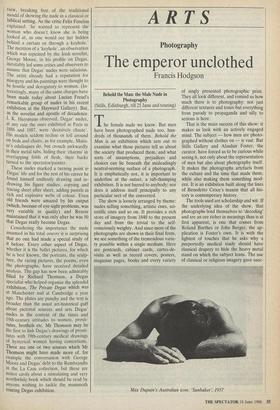ARTS
Photography
The emperor unclothed
Francis Hodgson
Behold the Man: the Male Nude in Photography (Stills, Edinburgh, till 25 June and touring)
The female nude we know. But men have been photographed nude too, hun- dreds of thousands of them. Behold the Man is an exhibition which sets out to examine what those pictures tell us about the society that produced them, and what sorts of assumptions, prejudices and choices can lie beneath the misleadingly neutral-seeming surface of a photograph. It is emphatically not, it is important to underline at the outset, a tub-thumping exhibition. It is not barred to anybody; nor does it address itself principally to any particular sect of the converted.
The show is loosely arranged by theme: nudes selling something, artistic ones, sci- entific ones and so on. It provides a rich store of imagery from 1840 to the present day and from the trivial to the self- consciously weighty. And since most of the photographs are shown in their final form, we see something of the tremendous varie- ty possible within a single medium. Here are postcards, cabinet cards, cartes-de- visite as well as record covers, posters, magazine pages, books and every variety of singly presented photographic print. They all look different, and remind us how much there is to photography: not just different textures and tones but everything from parody to propaganda and silly to serious is here.
That is the main success of this show: it makes us look with an actively engaged mind. The subject — how men are photo- graphed without clothes on — is vast. But Stills Gallery and Alasdair Foster, the curator, have forced us to be curious while seeing it, not only about the representation of men but also about photography itself. It makes the photographs artefacts from the culture and the time that made them, while also making them something mod- ern. It is an exhibition built along the lines of Benedetto Croce's maxim that all his- tory is contemporary history.
The tools used are scholarship and wit. If the underlying idea of the show, that photographs lend themselves to 'decoding' and are an ore richer in meanings than is at first apparent, is one that comes from Roland Barthes or John Berger, the ap- plication is Foster's own. It is with the lightest of touches that he asks why a purportedly medical study should have tlassical drapery to hide the heavy metal stand on which the subject leans. The use of classical or religious imagery gave sane- Max Dupain's Australian icon: `Sunbakerc 1937 tion to pictures which might otherwise simply have been rude, clearly enough, but this is the first exhibition which shows how the process works. So the classical bits and pieces which were the props in every daguerreotypist's studio become the fluted column on which a 1954 body-builder perches, and the Crucifixion becomes just another pose on the cover of a recent English `style' magazine.
If the show has a central theme, it is that pictures of nude men reflect the climate they were made in; a less controversial line could not have been taken. This allows the show to be informative and entertaining without being either ponderous or offen- sive. Everybody will have different favourite pictures from Behold the Man. There are beautifully made prints by mas- ter photographers (a darkly luminous Ado- nis by Gordon Anthony, Marey's striding man who looks like a commuter so late for work that he has not yet noticed his nudity) as well as anonymous trivia. Photography is largely a trivial occupation; putting the ephemeral and the commercial next to the distinguished teaches us about both.
Few recent shows have so well demons- trated how much photography changes according to the context in which it is seen, how, for example, one generation's `objec- tivity' can reek of prejudice to the next. There are some delightful curiosities: Frank Yerbury, the great architectural photographer, mysteriously published a book of studies of the human figure in 1918. One of them is here. So is Lewis Morley's 1963 portrait of David Frost using the back of a chair for a fig-leaf.
Calling male superiority into question has been as rare in photography over the years as it has in everything else. Behold the Man goes some way to blowing the whistle. It makes us ask more earnestly Carlyle's jesting question: 'Lives there a man who can figure a naked Duke of Windlestraw addressing a naked House of Lords?'



















































 Previous page
Previous page